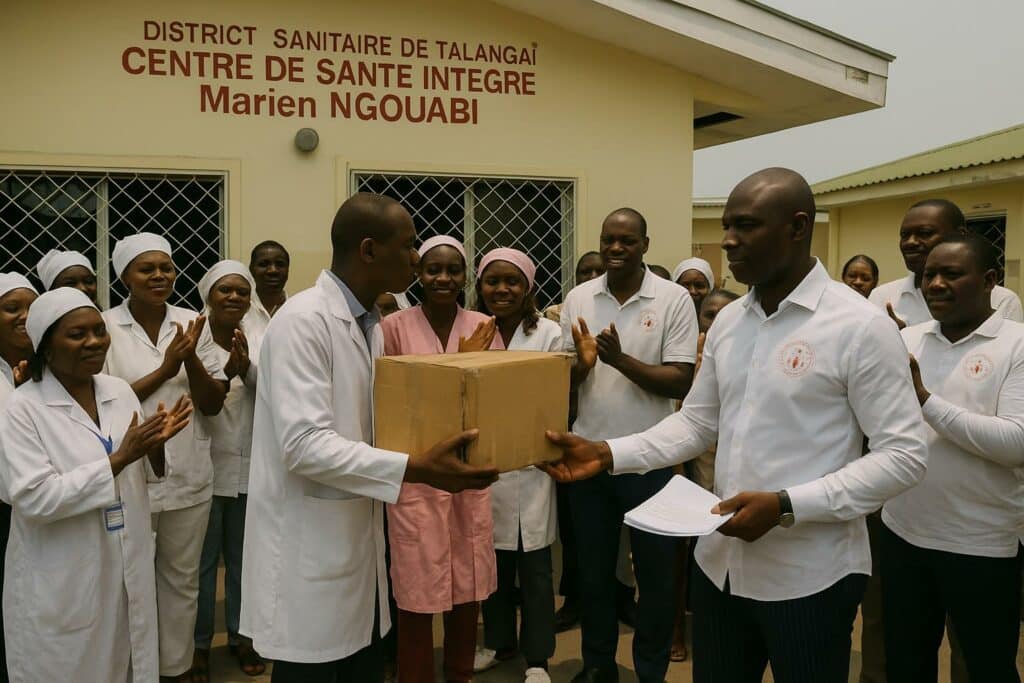A commemorative act of solidarity
On 19 September, the discreet courtyard of the Marien-Ngouabi Integrated Health Centre in Talangaï briefly resembled a logistics hub. Cartons sealed with the blue crest of the Julia-Bouya Foundation were unloaded one after another before being dispatched to neighbouring Moukondo, in Moungali. The operation, led by Dorel Eyobelé—personal representative of foundation president Débora Nyanguila—coincided with the fourth anniversary of Julia Bouya’s death, an occasion the organisation prefers to mark through concrete action rather than solemn speeches. “Madame Bouya believed in practical compassion,” Eyobelé recalled, adding that the donation sought “to strengthen front-line facilities where the demand for basic medicines remains acute”.
What the boxes contain—and why it matters
Inventoried in the presence of municipal health officers, the cargo comprised broad-spectrum antibiotics, antimalarials, analgesics, prenatal vitamins, sterile gauze and gloves. A second batch was exclusively reserved for maternal and child health: delivery kits, umbilical clamps, neonatal thermometers and iron-folate supplements. Dr. Clarisse Bilombo, head physician at Marien-Ngouabi, welcomed the shipment as “timely reassurance at a moment of recurrent stock-outs”. She emphasised that routine pathologies—malaria, respiratory infections and obstetric emergencies—account for most admissions, yet remain the most vulnerable to shortages.
Private generosity complementing public policy
Congo-Brazzaville has in recent years multiplied initiatives to universalise access to primary health care, notably through the Health Development Plan 2022-2026. Budgetary pressures, however, still limit procurement volumes at municipal level. Philanthropic contributions such as the Julia-Bouya Foundation’s thus function as flexible buffers, allowing facilities to maintain minimum stocks without disrupting official supply chains. A senior official at the Ministry of Health, speaking on background, acknowledged that “civil society partnerships enable us to bridge urgent gaps while structural reforms mature”.
Echoes from the wards
At Moukondo, the maternity wing records an average of twenty births per day. Midwife Jeanne-Lyse Ngakala underlined that a single postpartum haemorrhage can consume nearly all the unit’s available oxytocic ampoules. “With this delivery, we hold enough for at least the next quarter,” she said, pointing to freshly shelved vials. Nearby, young mothers listened to health educators explaining the importance of completing iron therapy—a recommendation now easier to honour thanks to the new stock.
Beyond charity: strategy and governance
Established in 2022, the Julia-Bouya Foundation frames its activities within a multi-year programme that also includes building community clinics, financing medical research and sustaining agricultural cooperatives that buttress household nutrition. Governance documents consulted by our newsroom indicate that the organisation allocates no more than ten percent of its annual budget to administrative overheads, in line with international best practice. For political observers, the foundation’s trajectory illustrates a broader trend in Central Africa: the rise of locally anchored philanthropies capable of mobilising diaspora funding and nurturing public-private synergies without overtly competing with state prerogatives.
Legal and economic lens
Under Congolese law, in-kind medical donations must comply with Order No. 4542 of 2016 regulating pharmaceutical quality and shelf life. According to the inspection report shared with us, all delivered products expire in 2025 or later, satisfying regulatory thresholds. Economists at the University of Brazzaville estimate the market value of the consignment at roughly 45 million CFA francs—a non-negligible injection when converted into savings for low-income patients whose out-of-pocket payments remain high.
What comes next
As cartons give way to daily prescriptions, attention turns to monitoring impact. The foundation has pledged to fund quarterly audits measuring reductions in drug stock-outs and maternal-neonatal complications at both centres. Should the data confirm initial expectations, the model could be replicated in semi-rural districts where infrastructure is thinner. For Dr. Bilombo, the success metric is simple: “When a mother leaves with a healthy child and without an unpaid bill, Julia Bouya’s vision lives on.”

